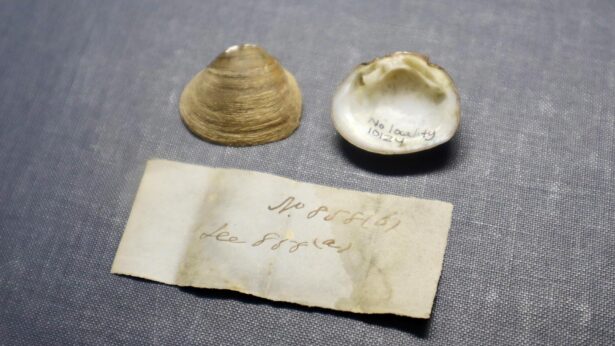Listen to this story
As University of Tennessee President Joseph Estabrook waded through the creek bordering the Knoxville campus looking for shells to add to his collection, he found a striking mussel that stood out from the others.
Upon examination, Estabrook realized he was unsure of the species. Determined to learn its identity, Estabrook sent the specimen to a well-known molluscan taxonomist named Isaac Lea at the Philadelphia Academy of Science.
Estabrook’s discovery of a new mussel species in the mid-1800s demonstrates a rich history of research and discovery for the University of Tennessee.
Today, discoveries from those like Estabrook inspire Gerry Dinkins (Knoxville ’80, ’84), the curator of malacology at the McClung Museum. Dinkins manages the Paul W. Parmalee Malacological Collection, which consists of almost 200,000 specimens and ranks among the largest in the United States.
“I’ve spent a lot of time studying Isaac Lea’s research, and the individuals sending Lea specimens were mostly physicians or clergy,” Dinkins says. “And I know of no other instance in which a university president, or somebody associated with academia at a high sort of organizational level, ever sent Lea specimens. So Estabrook is unique in that way.”
Upon receiving Estabrook’s mussel, Lea recognized it as an undiscovered species and named it Unio estabrookianus in honor of its collector.
UT’s fifth president served as a patronym for this mussel until later taxonomists concluded that the species had been discovered before and synonymized the mussel into its first recognition: pleuronaia barnesiana, more commonly known as the Tennessee pigtoe.
Aquatic mollusks, like the Tennessee pigtoe, play an essential role in the ecosystem. They serve as habitats and food for other organisms, aerate the substrate as they burrow and contribute to water quality.
“The presence of mussels indicates good water quality, and we all want good water quality,” Dinkins says. “We all want to live by a stream where our kids can play, jump in and swim.”
Yet, aquatic mollusks are now classified as one of the most imperiled animal groups in the United States, with 70 percent of mussel species considered endangered, threatened or imperiled. Historically, Tennessee was home to 140 species of mussels, but now 16 of those are extinct, according to Dinkins. Today, 53 mussel species from Tennessee are on the federal endangered list, and another three species may be added to the list soon, he says.
Estabrook’s mussel, the Tennessee pigtoe, is facing reclassification as either a threatened or endangered species. It once occurred in hundreds—if not thousands—of miles of the Tennessee River drainage in Tennessee, Georgia, Alabama, North Carolina and Virginia but is now restricted to just a few tributaries. The decline in aquatic mollusk populations can be attributed to water quality issues, poor land use and climate change, according to Dinkins.
Collections, like those at the McClung Museum, including specimens found by Estabrook, provide experts with proof of where species once occurred, which is necessary to determine if they warrant protection.
“If a species goes on the endangered species list, there are lots of restrictions on where the species can be introduced,” Dinkins says about restocking the waterways. “You need to know where it historically occurred before you try to reestablish a population. So that’s one of the most important parts of a collection like this.”
Through the research conducted by Dinkins, his predecessor Parmalee—who was the McClung Museum director—and Estabrook’s records, malacologists hope to restore the Tennessee pigtoe to its native waters, some of which flow near or through UT Knoxville’s campus.
“Estabrook’s legacy is he showed us where mussels were, and if we can restore those creeks and rivers to once again support some of the species that he discovered, it helps not only us but future generations to have clean water,” Dinkins says.

